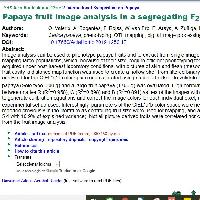Resumen
- Image analysis can be used to phenotype papaya fruits and to extract from single images as many fruit properties as possible. This becomes especially attractive for mapping large populations, which, because of their size, require efficient phenotyping tools. Thus, a pipeline to evaluate papaya fruit was developed. Papaya images were acquired under post-harvest laboratory conditions, with pictures of skin and flesh (mesocarp) taken to automatically determine fruit dimensions and color. To phenotype the fruit cavity, a distance map function was used to create a hollow shell from filtered binary images. To measure the color of the fruits from the images, the pictures were analyzed for the CIEL*a*b color space and calibrated using a color checker. To validate the method, a papaya F2 population, derived from the cross between a small-fruit papaya (Solo type, 300 g) and a large-fruit papaya (1700 g) was evaluated. High correlations between fruit weight and fruit area were obtained (R2=0.97). Correlations between native R (R2=0.958), G (R2=0.898) and B (R2=0.891) values of the images with those of the color checker were also high. The linear regression found was used to generate calibration equations and correct the image colors for each individual pixel, resulting in a significant correlation (p≤0.05) between the colorimeter and the experimental set up used. Interestingly, parameters of the CIEL*a*b color space were negatively correlated with fruit weight (R2=-0.69). Quantitative trait loci (QTL) reported previously in the literature as controlling fruit size were used for mapping, and a fruit weight and size (using digital images) QTL was again significant (LOD score 5.4 with 16.9% of explained variance). Not all picture-derived traits were correlated nor controlled by the mapped QTLs, thus indicating the presence of novel traits derived from the fruit image analysis.
